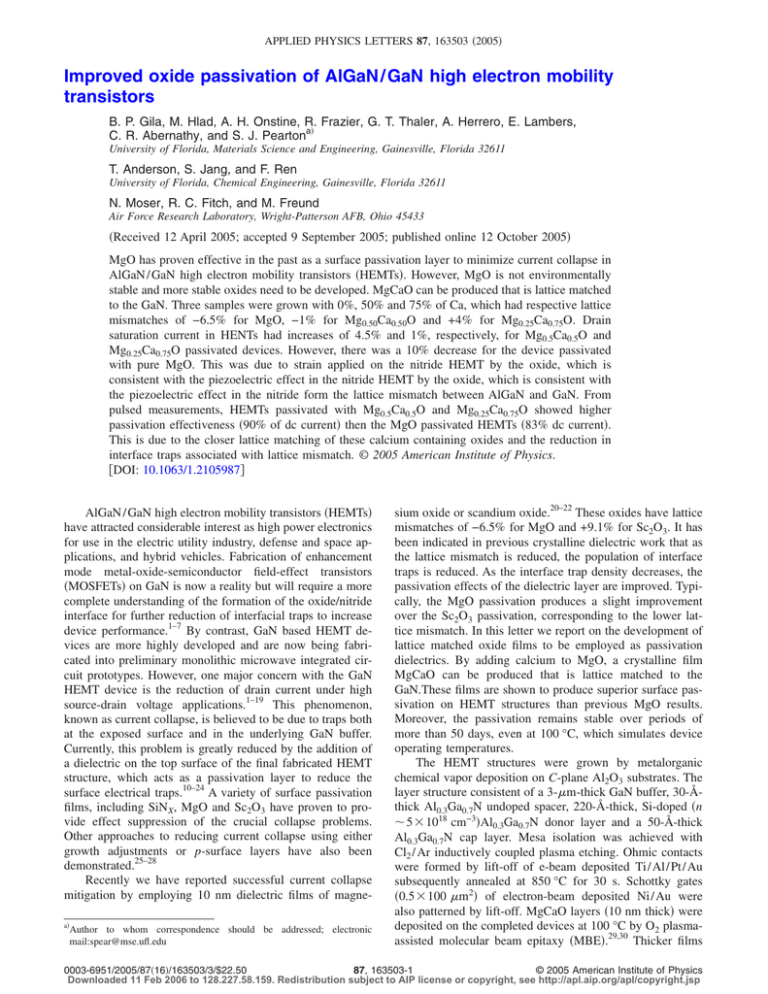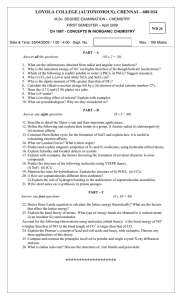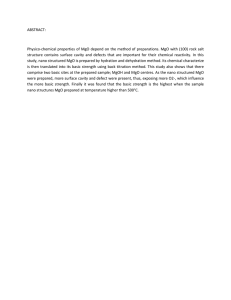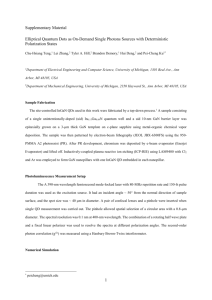Improved oxide passivation of AlGaN/GaN high
advertisement

APPLIED PHYSICS LETTERS 87, 163503 共2005兲 Improved oxide passivation of AlGaN / GaN high electron mobility transistors B. P. Gila, M. Hlad, A. H. Onstine, R. Frazier, G. T. Thaler, A. Herrero, E. Lambers, C. R. Abernathy, and S. J. Peartona兲 University of Florida, Materials Science and Engineering, Gainesville, Florida 32611 T. Anderson, S. Jang, and F. Ren University of Florida, Chemical Engineering, Gainesville, Florida 32611 N. Moser, R. C. Fitch, and M. Freund Air Force Research Laboratory, Wright-Patterson AFB, Ohio 45433 共Received 12 April 2005; accepted 9 September 2005; published online 12 October 2005兲 MgO has proven effective in the past as a surface passivation layer to minimize current collapse in AlGaN / GaN high electron mobility transistors 共HEMTs兲. However, MgO is not environmentally stable and more stable oxides need to be developed. MgCaO can be produced that is lattice matched to the GaN. Three samples were grown with 0%, 50% and 75% of Ca, which had respective lattice mismatches of −6.5% for MgO, −1% for Mg0.50Ca0.50O and +4% for Mg0.25Ca0.75O. Drain saturation current in HENTs had increases of 4.5% and 1%, respectively, for Mg0.5Ca0.5O and Mg0.25Ca0.75O passivated devices. However, there was a 10% decrease for the device passivated with pure MgO. This was due to strain applied on the nitride HEMT by the oxide, which is consistent with the piezoelectric effect in the nitride HEMT by the oxide, which is consistent with the piezoelectric effect in the nitride form the lattice mismatch between AlGaN and GaN. From pulsed measurements, HEMTs passivated with Mg0.5Ca0.5O and Mg0.25Ca0.75O showed higher passivation effectiveness 共90% of dc current兲 then the MgO passivated HEMTs 共83% dc current兲. This is due to the closer lattice matching of these calcium containing oxides and the reduction in interface traps associated with lattice mismatch. © 2005 American Institute of Physics. 关DOI: 10.1063/1.2105987兴 AlGaN / GaN high electron mobility transistors 共HEMTs兲 have attracted considerable interest as high power electronics for use in the electric utility industry, defense and space applications, and hybrid vehicles. Fabrication of enhancement mode metal-oxide-semiconductor field-effect transistors 共MOSFETs兲 on GaN is now a reality but will require a more complete understanding of the formation of the oxide/nitride interface for further reduction of interfacial traps to increase device performance.1–7 By contrast, GaN based HEMT devices are more highly developed and are now being fabricated into preliminary monolithic microwave integrated circuit prototypes. However, one major concern with the GaN HEMT device is the reduction of drain current under high source-drain voltage applications.1–19 This phenomenon, known as current collapse, is believed to be due to traps both at the exposed surface and in the underlying GaN buffer. Currently, this problem is greatly reduced by the addition of a dielectric on the top surface of the final fabricated HEMT structure, which acts as a passivation layer to reduce the surface electrical traps.10–24 A variety of surface passivation films, including SiNX, MgO and Sc2O3 have proven to provide effect suppression of the crucial collapse problems. Other approaches to reducing current collapse using either growth adjustments or p-surface layers have also been demonstrated.25–28 Recently we have reported successful current collapse mitigation by employing 10 nm dielectric films of magnea兲 Author to whom correspondence should be addressed; electronic mail:spear@mse.ufl.edu sium oxide or scandium oxide.20–22 These oxides have lattice mismatches of −6.5% for MgO and +9.1% for Sc2O3. It has been indicated in previous crystalline dielectric work that as the lattice mismatch is reduced, the population of interface traps is reduced. As the interface trap density decreases, the passivation effects of the dielectric layer are improved. Typically, the MgO passivation produces a slight improvement over the Sc2O3 passivation, corresponding to the lower lattice mismatch. In this letter we report on the development of lattice matched oxide films to be employed as passivation dielectrics. By adding calcium to MgO, a crystalline film MgCaO can be produced that is lattice matched to the GaN.These films are shown to produce superior surface passivation on HEMT structures than previous MgO results. Moreover, the passivation remains stable over periods of more than 50 days, even at 100 °C, which simulates device operating temperatures. The HEMT structures were grown by metalorganic chemical vapor deposition on C-plane Al2O3 substrates. The layer structure consistent of a 3-m-thick GaN buffer, 30-Åthick Al0.3Ga0.7N undoped spacer, 220-Å-thick, Si-doped 共n ⬃ 5 ⫻ 1018 cm−3兲Al0.3Ga0.7N donor layer and a 50-Å-thick Al0.3Ga0.7N cap layer. Mesa isolation was achieved with Cl2 / Ar inductively coupled plasma etching. Ohmic contacts were formed by lift-off of e-beam deposited Ti/ Al/ Pt/ Au subsequently annealed at 850 °C for 30 s. Schottky gates 共0.5⫻ 100 m2兲 of electron-beam deposited Ni/ Au were also patterned by lift-off. MgCaO layers 共10 nm thick兲 were deposited on the completed devices at 100 °C by O2 plasmaassisted molecular beam epitaxy 共MBE兲.29,30 Thicker films 0003-6951/2005/87共16兲/163503/3/$22.50 87, 163503-1 © 2005 American Institute of Physics Downloaded 11 Feb 2006 to 128.227.58.159. Redistribution subject to AIP license or copyright, see http://apl.aip.org/apl/copyright.jsp 163503-2 Appl. Phys. Lett. 87, 163503 共2005兲 Gila et al. TABLE I. Composition of the three different surface passivation films investigated, as obtained from AES measurements. Sample Mg/ O Ca/ O Mg/ 共Mg+ Ca兲 MgO MgCaO 共10:10兲 MgCaO 共5:15兲 0.58 0.34 0.25 0 0.52 0.94 1 0.40 0.21 共100 nm兲 were used for characterization of their properties by Auger electron spectroscopy 共AES兲 and x-ray diffraction 共XRD兲. Table I shows the characteristics of the three different compositions of films examined. All oxide growth was performed in a modified RIBER 2300 MBE equipped with a reflection high-energy electron diffraction system. Oxide growth was performed using a standard effusions oven containing Mg 共99.99%兲 operating at 375 °C, Ca 共99.9%兲 operating at 413 °C and Sc 共99.999%兲 operating at 1190 °C. Atomic oxygen was supplied from an Oxford MPD21 radio frequency plasma source with 300 W forward power at 8 ⫻ 10−6 Torr oxygen pressure. The addition of Ca at a comparable Mg beam equivalent pressure 共BEP兲 produced an increase of less than 50% in growth rate. This suggests that the sticking coefficient of the Ca is significantly lower than that of the Mg. Initially conditions were set so that the Mg and Ca fluxes were equal and the substrate temperature was 300 °C. An initial shutter sequence of 10 sec of Mg and 10 sec of Ca, repeatedly, with a continuous exposure from the oxygen plasma was used. Atomic force microscopy showed that the digital samples had a slightly smoother surface than the continuous samples. The growth rate of the continuous samples was about twice that of the digital samples. The characteristics of passivated HEMTs were measured in dc and pulsed mode. Figure 1 shows an AES depth profile of the Mg0.5Ca0.5O film on GaN. The interfaces are sharp and the films show uniform compositions throughout their depth. Similar results were obtained for the Mg0.25Ca0.75O and MgO films. The surface scans showed no evidence of Ga or N out-diffusion to the surface of the films. The x-ray rocking curves are shown for the three films on GaN in Fig. 2. The MgCaO layer shows no evidence of either the MgO or the CaO 共222兲 peaks, suggesting that phase separation into the two binaries has not occurred. Instead there appears to be a shoulder to the right of the GaN 共004兲 peak that is not observed in spectra taken from either GaN substrates or MgO layers grown FIG. 2. XRD scans from MgO, Mg0.5Ca0.5O and Mg0.25Ca0.75O films on GaN. on GaN. This peak is the 共222兲 peak from the ternary MgCaO. The peak position continues to shift to larger plane spacing relative to the MgO peak as the BEP of Ca is increased. Both of the MgCaO films show closer lattice match to the GaN than pure MgO, i.e., −1% for Mg0.50Ca0.50O and +4% for Mg0.25Ca0.75O compared to −6.5% for MgO. Gate lag measurements were performed as shown in Fig. 3, where the drain-source voltage VDS was fixed at a low enough voltage 共3 V兲 to avoid self-heating and the drainsource current was measured as the gate voltage was switched from −5 V to the value shown in the x axis. The measurements were performed at 1 MHz with a 10% duty cycle. There is much less degradation in IDS in the passivated HEMTs compared to the unpassivated devices. Drain saturation current in HEMTs had increases of 4.5% and 1%, respectively, for Mg0.5Ca0.5O and Mg0.25Ca0.75O passivated devices. However, there was a 10% decrease for the device passivated with pure MgO. This was due to strain applied on the nitride HEMT by the oxide. The unpassivated devices show a decrease of ⬃50% in drain-source current. This can be effectively mitigated by thin MgCaO layers. The long-term stability of the passivation by the MgCaO films was examined by Hall measurements. Both environmental and thermal stability are important for the viability of a passivation oxide under processing conditions and device operation. The environmental stability of the oxides was tested under the accelerated aging conditions of 100% humidity and temperatures above 100 °C. The stability of the FIG. 3. Gate lag measurement of AlGaN / GaN HEMTs with gate voltage pulsed from −5 V to the value shown on the x axis. The devices were measured either without any surface passivation or with MgCaO films of FIG. 1. AES depth profile of a Mg0.5Ca0.5O film on GaN. different composition. Downloaded 11 Feb 2006 to 128.227.58.159. Redistribution subject to AIP license or copyright, see http://apl.aip.org/apl/copyright.jsp 163503-3 Gila et al. Appl. Phys. Lett. 87, 163503 共2005兲 Saygi, G. Simin, J. Yang, M. A. Khan, A. Tarakji, M. S. Shur, and R. Gaska, IEEE Electron Device Lett. 24, 514 共2003兲. 3 A. Tarakji, H. Fatima, X. Hu, J. P. Zhang, G. Simin, M. A. Khan, M. S. Shur, and R. Gaska, IEEE Electron Device Lett. 24, 369 共2003兲. 4 G. Simin, A. Koudymov, H. Fatima, J. Zhang, J. Yang, M. Asif Khan, X. Hu, A. Tarakji, R. Gaska, and M. S. Shur, IEEE Electron Device Lett. 23,458 共2002兲. 5 M. A. Khan, X. Hu, G. Simin, A. Lunev, J. Yang, R. Gaska, and M. S. Shur, IEEE Electron Device Lett. 21,63 共2000兲. 6 S. Rajan, H. Xing, D. Jena, S. P. DenBaars, and U. K. Mishra, Appl. Phys. Lett. 84, 1591 共2004兲. 7 X. Hu, A. Koudymov, G. Simin, J. Yang, M. Asif Khan, A. Tarakji, M. S. Shur, and R. Gaska, Appl. Phys. Lett. 79, 2832 共2001兲. 8 I. Daumiller, C. Kirchner, M. Kamp, K. J. Ebeling, and E. Kohn, IEEE Electron Device Lett. 20, 448 共1999兲. 9 E. Kohn, I. Daumiller, P. Schmid, N. X. Nguyen, and C. N. Nguyen, Electron. Lett. 35, 1022 共1999兲. 10 B. M. Green, K. K. Chu, E. M. Chumbes, J. A. Smart, J. R. Shealy, and L. F. Eastman, IEEE Electron Device Lett. 21, 268 共2000兲. FIG. 4. Time dependence of sheet carrier concentration in HEMT structure 11 S. C. Binari, K. Ikossi, J. A. Roussos, W. Kruppa, D. Park, H. B. Dietrich, before and after passivation with MgCaO and subsequent aging at room D. D. Koleske, A. E. Wickenden, and R. L. Henry, 48, 465 共2001兲. temperature of 100 °C. 12 R. Vetury, N. Q. Zhang, S. Keller, and U. K. Mishra, 48, 560 共2001兲. 13 T. G. G. Maffeis, M. C. Simmonds, S. A. Clark, F. Peiro, P. Haines, and P. J. Parbrook, J. Phys. D 33, L115 共2000兲. films was measured as the change of the index of refraction, 14 J.-S. Lee, A. Vescan, A. Wieszt, R. Dietrich, H. Leier, and Y.-S. Kwon, n, over time. Pure MgO films were found to degrade over Electron. Lett. 37, 130 共2001兲. time in atmosphere due to the presence of water vapor. The 15 F. Ren and J. C. Zolper, Wide Energy Bandgap Electronic Device 共World water vapor reacts with the MgO to form magnesium hyScientific, Singapore, 2003兲. 16 droxide, Mg共OH兲2. Uncapped MgCaO also showed degradaW. Lu, V. Kumar, R. Schwindt, E. Piner, and I. Adesida, Solid-State Electron. 46, 1441 共2002兲. tion after annealing, but less severely than the MgO. By 17 W. S. Tan, P. A. Houston, P. J. Parbrook, G. Hill, and R. J. Airey, J. Phys. sharp contrast, MgCaO films capped with 5 nm of Sc2O3 D 35, 595 共2002兲. showed only slight differences after annealing. The majority 18 L. F. Eastman, V. Tilak, J. Smart, B. M. Green, E. M. Chumbes, R. Dimof this difference comes from a change in the capping layer itrov, H. Kim, O. S. Ambacher, N. Weimann, T. Prunty, M. Murphy, W. J. possibly due to recrystallization of the polycrystalline scanSchaff, and J. R. Shealy, IEEE Trans. Electron Devices 48, 479 共2001兲. 19 S. Keller, Y.-F. Wu, G. Parish, N. Ziang, J. J. Xu, B. P. Keller, S. P. dium oxide capping layer. More importantly, the interface DenBaars, and U. K. Mishra, IEEE Trans. Electron Devices 48, 552 roughness of the oxide/nitride interface does not appear to be 共2001兲. greatly affected by even 1000 °C anneals, indicating that the 20 B. Luo, J. W. Johnson, J. Kim, R. M. Mehandru, F. Ren, B. P. Gila, A. H. additional Sc2O3 cap layer will play a major role in any Onstine, C. R. Abernathy, S. J. Pearton, A. G. Baca, R. D. Briggs, R. J. additional high temperature processing. Shul, C. Monier, and J. Han, Appl. Phys. Lett. 80, 1661 共2001兲. 21 J. Gillespie, R. C. Fitch, J. Sewell, R. Dettmer, G. Via, A. Crespo, T. Hall effect samples were fabricated from unprocessed Jenkins, B. Luo, R. Mehandru, J. Kim, F. Ren, B. P. Gila, A. H. Onstine, HEMT material. The samples were then subjected to the C. R. Abernathy and S. J. Pearton, IEEE Electron Device Lett. 23, 505 standard HEMT cleaning process and MgCaO passivation 共2002兲. 22 deposition. An increase in sheet carrier density of ⬃15% was B. Luo, J. W. Johnson, B. P. Gila, C. R. Abernathy, F. Ren, S. J. Pearton, observed after the passivation process. This trend is consisA. G. Baca, A. M. Dabiran, A. M. Wowchack, and P. P. Chow, Solid-State Electron. 46, 467 共2002兲. tent with that reported for passivation with SiO2 and 23 B. J. Ansell, I. Harrison, and C. T. Foxon, Phys. Status Solidi A 188, 279 SiNx.31–34 These values were stable over several days 共Fig. 共2001兲. 4兲. One sample was annealed at 100 °C in a box furnace 24 R. Coffie, D. Buttari, S. Heikman, S. Keller, A. Chini, L. Shen, and U. K. open to room ambient while the other was maintained at Mishra, IEEE Electron Device Lett. 23, 588 共2002兲. 25 room temperature. These samples were tested for a total of N. G. Weimann, M. J. Manfra, and T. Wachtler, IEEE Electron Device Lett. 24, 57 共2003兲. 25 days. No appreciable decrease in the sheet carrier concen26 L. Shen, R. Coffie, D. Buttari, S. Heikman, A. Chakraborty, A. Chini, S. tration was observed. These results indicate that the passivaKeller, S. P. DenBaars, and U. K. Mishra, IEEE Electron Device Lett. 25, tion is very stable at 100 °C. This stability should only in79 共2004兲. 27 crease as the lattice mismatch decreases and the 5 nm Sc2O3 L. Shen, R. Coffie, D. Buttari, S. Heikman, A. Chakraborty, A. Chini, S. Keller, S. P. DenBaars, and U. K. Mishra, J. Electron. Mater. 33, 422 cap is employed. 共2004兲. In summary, the near lattice matched MgCaO grown via 28 R. Chu, Y. Zhou, J. Liu, D. Wang, K. J. Chen, and K. M. Lau, IEEE Trans. a digital alloy approach has proven to be more thermally Electron Devices 52, 438 共2005兲. 29 stable than the currently employed MgO. The approach of a B. P. Gila, J. W. Johnson, R. Mehandru, B. Luo, A. H. Onstine, V. Krishreduced defect density single crystal MgCaO interfacial layer namoorthy, S. Bates, C. R. Abernathy, F. Ren, and S. J. Pearton, Phys. Status Solidi A 188, 239 共2001兲. capped with a poly-crystalline Sc2O3 layer represents the 30 J. Kim, R. Mehandru, B. Luo, F. Ren, B. P. Gila, A. H. Onstine, C. R. most stable heterostructure for passivation. Abernathy, S. J. Pearton, and Y. Irokawa, Appl. Phys. Lett. 80, 4555 共2000兲. This work at UF is partially supported by AFOSR 31 X. Z. Dang, E. T. Yu, E. J. Piner, and B. T. McDermott, J. Appl. Phys. 90, 共F49620-02-1-0366, G. Witt兲, ONR 共N0014-98-1-02-04, H. 1357 共2001兲. 32 B. Dietrich兲 and NSF DMR0101438. J. Bernat, P. Javorka, M. Marso, and P. Kordos, Appl. Phys. Lett. 83, 5455 共2003兲. 33 1 J. Bernat, P. Javorka, A. Fox, M. Marso, H. Luth, and P. Kordos, Electron. M. S. Shur and M. A. Khan, GaN and AlGaN Devices: FETs and PhotoLett. 39, 1155 共2003兲. detectors, in GaN and Related Materials II, edited by S. J. Pearton 共Gor34 J. Bernat, P. Javorka, A. Fox, M. Marso, H. Luth, and P. Kordos, Soliddon and Breach, Netherlands, 1999兲, pp. 47–92. 2 State Electron. 47, 2097 共2003兲. V. Adivarahan, M. Gaevski, W. H. Sun, H. Fatima, A. Koudymov, S. Downloaded 11 Feb 2006 to 128.227.58.159. Redistribution subject to AIP license or copyright, see http://apl.aip.org/apl/copyright.jsp



